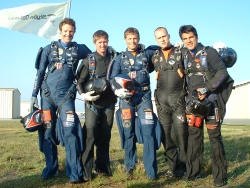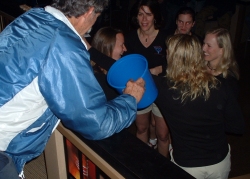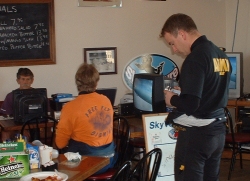
National
Skydiving
League
226 Pecan Street
Deland FL 32724
tel: (386) 801-0804
© 2003 - 2024
All Rights Reserved


226 Pecan Street
Deland FL 32724
tel: (386) 801-0804
© 2003 - 2024
All Rights Reserved

It surely is not easy to find the flaw. It happens at the Block 17 maneuver on the second page. The first thing that probably caught the judge's attention is the fact that the grip sequence building the Danish T is different compared to the Danish T on the first page.
DeLand Majik's technique for this block includes that the single flyer usually takes the leg grip of the person he/she will fly over first. Then the single flyer completes the Danish T by taking the arm grip on the center person of the Compressed Accordeon.

The rules certainly do not require a specific grip order to build any formation. The DeLand Majik members had their own reasons why they suddenly saw the need to build this Danish T in a different way. This time, on the second page, the single flyer took the arm grip first and then followed up with the leg grip.

This is nothing unusual, as well. In fact, loading up and initiating momentum has become a very helpful part of many techniques in recent years. It usually helps to create positive energy for the actual maneuver of a block technique.
It was a little bit different in this case. The center was still working on the grip connections and dealing with a different grip order. The increasing tension within the formation did not make it much easier to complete the last open leg grip. The center person's arms were stretched out wide to the maximum.

Unfortunately for Majik, the judge's attention was now focused on this situation, and the actual block maneuver was not completed yet. DeLand Majik had saved the Danish T as a scoring formation despite the unplanned grip order building it, but the single flyer still had to deal with a stressed formation and an uncomfortable starting position for the upcoming vertical maneuver.
Result of the stressed Danish T was the difficulty for the single flyer to perform a clean vertical maneuver. Whenever Block 17 comes up, judges are educated and prepared to check if there is at least a clean window long enough to see separation between the 3-way piece and the single flyer.
This is the point where the Shamrock Showdown's event judge, Richard Schachner, most likely gave up on Majik's efforts to rescue the whole block. The single Majik flyer helped himself out of the unusual situation by holding on to the leg grip longer than usual while crossing over vertically. In fact, he made already contact with his new arm grip of the Murphy, while he was either still holding on to the old leg grip of the Danish T, or he did not offer the video and the judge the opportunity to see the separation.

It was an unfortunate situation for DeLand Majik and caused by a chain reaction of events. The judge might have never seen the same infringement of the inter (no separation between the single flyer and the piece) if the unusual grip order building the Danish T in combination with the early start of the outside position had not caught his attention.
On the other side and for a different case, even a questionable grip order and completion of the formation might have been rescued with a clean vertical maneuver and good separation. Judges like to see "clear presentation", a term which has now even beed added to the language of the rules, not to everybody's liking though.
What's the conclusion of this case study? The NSL Forum offers the stage to discuss this topic.
The top coaches have good reasons when they teach procedures and discipline, including the grip orders. It is very helpful to stick with these plans as much as possible. However, things can happen in freefall and can cause a change of the plans. This is where the coaches have the next recommendation: move on without much thinking and make the best out of it.
DeLand Majik did not show signs of any distraction at all, moved on very successfully and set a great example how to deal with such a situation. It required a very sharp eye to detect the infringement.